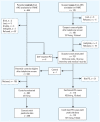Rotenone, paraquat, and Parkinson's disease
- PMID: 21269927
- PMCID: PMC3114824
- DOI: 10.1289/ehp.1002839
Rotenone, paraquat, and Parkinson's disease
Abstract
Background: Mitochondrial dysfunction and oxidative stress are pathophysiologic mechanisms implicated in experimental models and genetic forms of Parkinson's disease (PD). Certain pesticides may affect these mechanisms, but no pesticide has been definitively associated with PD in humans.
Objectives: Our goal was to determine whether pesticides that cause mitochondrial dysfunction or oxidative stress are associated with PD or clinical features of parkinsonism in humans.
Methods: We assessed lifetime use of pesticides selected by mechanism in a case-control study nested in the Agricultural Health Study (AHS). PD was diagnosed by movement disorders specialists. Controls were a stratified random sample of all AHS participants frequency-matched to cases by age, sex, and state at approximately three controls:one case.
Results: In 110 PD cases and 358 controls, PD was associated with use of a group of pesticides that inhibit mitochondrial complex I [odds ratio (OR)=1.7; 95% confidence interval (CI), 1.0-2.8] including rotenone (OR=2.5; 95% CI, 1.3-4.7) and with use of a group of pesticides that cause oxidative stress (OR = 2.0; 95% CI, 1.2-3.6), including paraquat (OR=2.5; 95% CI, 1.4-4.7).
Conclusions: PD was positively associated with two groups of pesticides defined by mechanisms implicated experimentally-those that impair mitochondrial function and those that increase oxidative stress-supporting a role for these mechanisms in PD pathophysiology.
Figures

Comment in
-
Rotenone and paraquat linked to Parkinson's disease: human exposure study supports years of animal studies.Environ Health Perspect. 2011 Jun;119(6):A259. doi: 10.1289/ehp.119-a259a. Environ Health Perspect. 2011. PMID: 21628118 Free PMC article. No abstract available.
Similar articles
-
Protective glove use and hygiene habits modify the associations of specific pesticides with Parkinson's disease.Environ Int. 2015 Feb;75:144-50. doi: 10.1016/j.envint.2014.11.002. Epub 2014 Nov 21. Environ Int. 2015. PMID: 25461423 Free PMC article.
-
Pesticide/environmental exposures and Parkinson's disease in East Texas.J Agromedicine. 2008;13(1):37-48. doi: 10.1080/10599240801986215. J Agromedicine. 2008. PMID: 19042691
-
Editor's Highlight: Base Excision Repair Variants and Pesticide Exposure Increase Parkinson's Disease Risk.Toxicol Sci. 2017 Jul 1;158(1):188-198. doi: 10.1093/toxsci/kfx086. Toxicol Sci. 2017. PMID: 28460087 Free PMC article.
-
Paraquat and Parkinson's disease: an overview of the epidemiology and a review of two recent studies.Regul Toxicol Pharmacol. 2012 Mar;62(2):385-92. doi: 10.1016/j.yrtph.2011.10.004. Epub 2011 Oct 15. Regul Toxicol Pharmacol. 2012. PMID: 22024235 Review.
-
Paraquat- and rotenone-induced models of Parkinson's disease.Int J Immunopathol Pharmacol. 2011 Apr-Jun;24(2):313-22. doi: 10.1177/039463201102400205. Int J Immunopathol Pharmacol. 2011. PMID: 21658306 Review.
Cited by
-
Health phenome of Parkinson's patients reveals prominent mood-sleep cluster.Res Sq [Preprint]. 2023 Dec 22:rs.3.rs-3683455. doi: 10.21203/rs.3.rs-3683455/v1. Res Sq. 2023. PMID: 38196602 Free PMC article. Preprint.
-
Distinct effects of rotenone, 1-methyl-4-phenylpyridinium and 6-hydroxydopamine on cellular bioenergetics and cell death.PLoS One. 2012;7(9):e44610. doi: 10.1371/journal.pone.0044610. Epub 2012 Sep 6. PLoS One. 2012. PMID: 22970265 Free PMC article.
-
Temperature-dependent changes in the host-seeking behaviors of parasitic nematodes.BMC Biol. 2016 May 6;14:36. doi: 10.1186/s12915-016-0259-0. BMC Biol. 2016. PMID: 27154502 Free PMC article.
-
Cerebrospinal fluid biomarker candidates for parkinsonian disorders.Front Neurol. 2013 Jan 21;3:187. doi: 10.3389/fneur.2012.00187. eCollection 2012. Front Neurol. 2013. PMID: 23346074 Free PMC article.
-
Changes in the sympathetic innervation of the gut in rotenone treated mice as possible early biomarker for Parkinson's disease.Clin Auton Res. 2016 Jun;26(3):211-22. doi: 10.1007/s10286-016-0358-6. Epub 2016 May 13. Clin Auton Res. 2016. PMID: 27178445 Free PMC article.
References
-
- Abbott RD, Petrovitch H, White LR, Masaki KH, Tanner CM, Curb JD, et al. Frequency of bowel movements and the future risk of Parkinson’s disease. Neurology. 2001;57(3):456–462. - PubMed
-
- Armed Forces Pest Management Board. Permethrin – Impregnated Clothing. 2010. [[accessed 4 November 2010]]. Available: http://fhpr.osd.mil/factsheetDetail.jsp?fact=27.
-
- ATSDR (Agency for Toxic Substances and Disease Registry) Home page. 2002. [[accessed 15 January 2002]]. Available: http://www.atsdr.cdc.gov/
-
- Bain P, Brin M, Deuschl G, Elble R, Jankovic J, Findley L, et al. Criteria for the diagnosis of essential tremor. Neurology. 2000;54(11 suppl 4):S7. - PubMed
Publication types
MeSH terms
Substances
Grants and funding
LinkOut - more resources
Full Text Sources
Other Literature Sources
Medical

